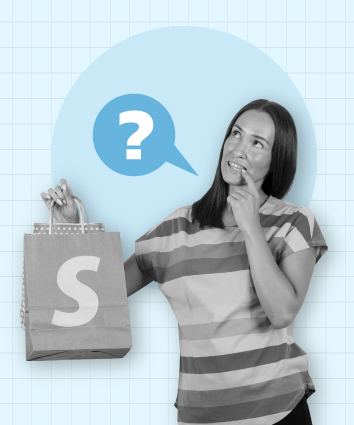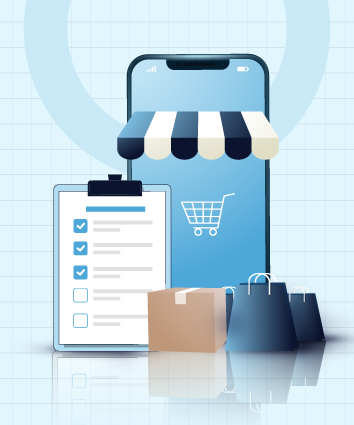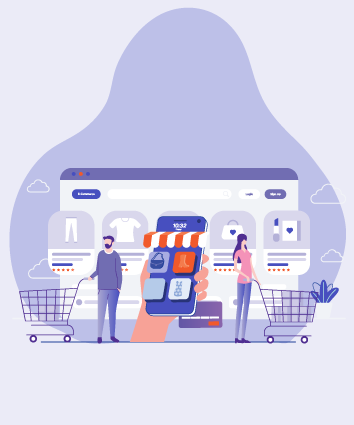E-Commerce Sales Funnel: A Step-by-Step Guide to Success
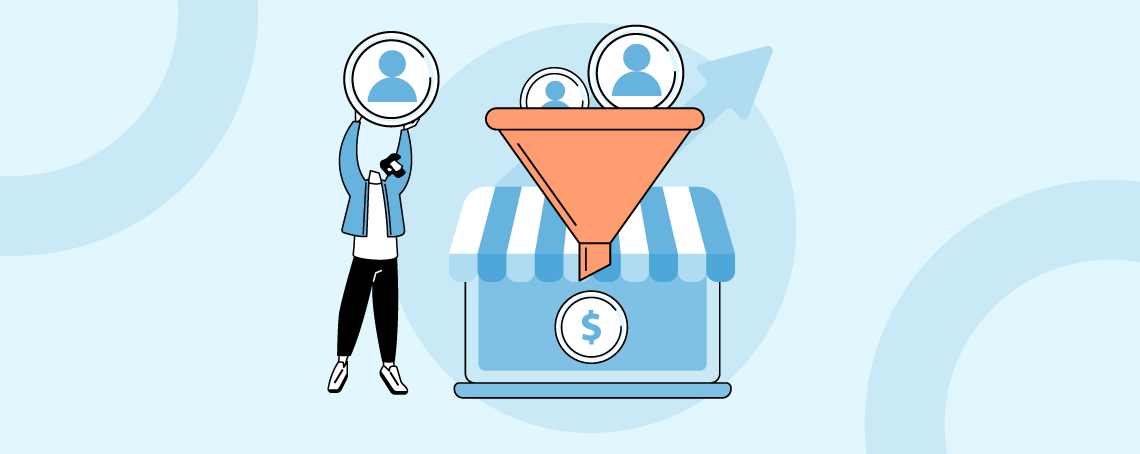
Comprehending your clients’ journey can aid in refining your digital marketing tactics and boosting your conversion rate. Based on our expertise, many clients require guidance to visualize the e-commerce sales funnel in a manner advantageous for both the customer and their enterprise. They often view it as a straightforward progression from A to B; however, dissecting it into distinct phases is more effective.
This article will demonstrate how grasping the usual customer journey can help augment your e-commerce sales funnel’s conversion and retention rates. We have plenty of ground to cover, so let’s begin.
What is an e-commerce sales funnel?
An e-commerce sales funnel represents the stages a potential customer undergoes until becoming an actual one and potentially remaining loyal to the brand. Customers may move swiftly through the funnel, impulsively deciding upon seeing a product to ultimately purchasing it, or their journey could span several months or even years before concluding in a sale.
To illustrate this idea, consider the following example of a basic e-commerce sales funnel:
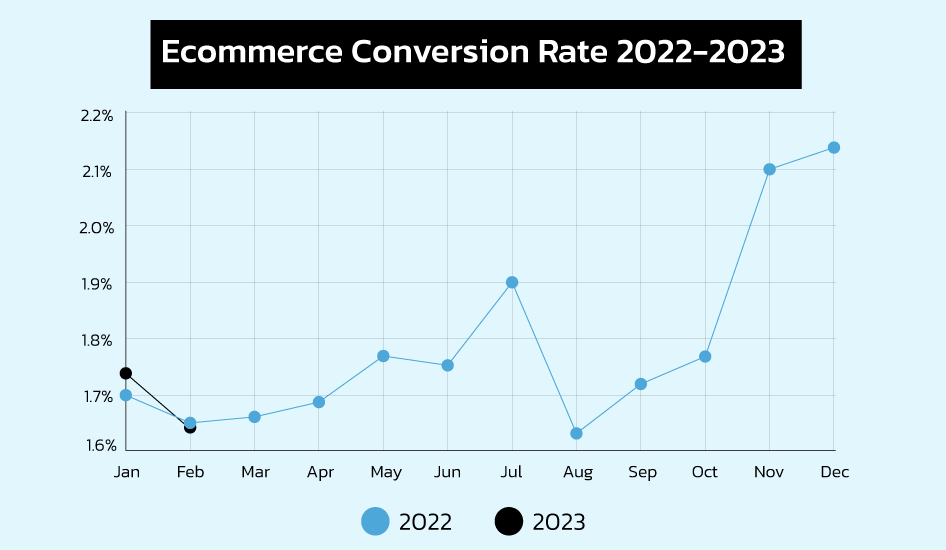
Recent surveys and studies conducted in 2023 indicate that the worldwide average conversion rate currently stands at 3.68%. Within the e-commerce industry, there has been a decline of 0.91% in the average conversion rate between February 2022 and February 2023, dropping from 1.65% to 1.64%.
Why Should You Create Your E-commerce Funnel?
Creating an e-commerce funnel can significantly improve your online business success by guiding customers through a well-defined sales journey.
The following points explain the benefits of designing and implementing an effective e-commerce funnel:
Enhanced customer experience
An e-commerce funnel tailors the shopping experience to individual customers based on their preferences and browsing history. By providing personalized recommendations, special offers, and a seamless checkout process, your e-commerce site becomes more user-friendly and engaging. This leads to increased customer satisfaction, loyalty, and repeat purchases.
Targeted marketing efforts
With an e-commerce funnel, you can segment your audience based on their behaviours and interests. This lets you focus your marketing strategies on specific groups and deliver highly relevant content and promotions. Consequently, your advertising spending becomes more efficient, resulting in higher conversion rates and lower acquisition costs.
Reduced cart abandonment rate
One critical aspect of an e-commerce funnel is optimizing the checkout process. Removing friction and offering multiple payment options can minimize cart abandonment and increase the likelihood of successful transactions. A streamlined checkout process also encourages impulse buying, further boosting revenue growth.
Better analytics and tracking
An e-commerce funnel provides valuable insights into consumer behaviour throughout the purchasing cycle. You can track users’ interactions with your website, identify pain points, and adjust your strategy accordingly. Accurate analytics like GA4 enable you to measure the effectiveness of your funnel and fine-tune it for maximum impact.
Competitive differentiation
In today’s crowded e-commerce landscape, having a well-designed e-commerce funnel sets your brand apart from competitors. It demonstrates a commitment to customer experience and shows that you prioritize their needs and preferences.
What Is an E-Commerce Sales Funnel?
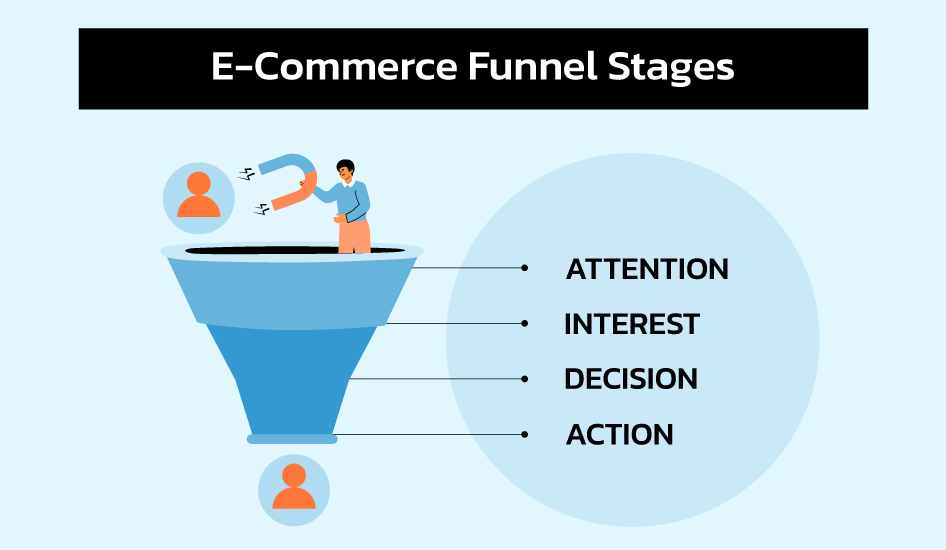
An e-commerce sales funnel is the marketing term that describes potential customers’ journey from visitor to a buyer.
There are several steps to an e-commerce sales funnel, usually known as the top, middle, and bottom of the funnel. However, these steps may vary depending on the retailer’s sales model.
Stage 1: Attention
To successfully capture the attention of potential customers during the attention stage, e-commerce sites must employ paid and organic methods to drive targeted traffic to their platforms. Paid advertising channels like Google Ads and Facebook ads allow merchants to place their products in front of a larger, targeted audience, which increases the chances of capturing the interest of those actively searching for solutions to their problems.
On the other hand, organic search engine optimization (SEO) and content marketing aim to improve visibility in search results and build trust with prospective buyers, thereby driving more qualified traffic to the site.
Ultimately, the key objective during the awareness stage is to showcase your expertise and authority in the industry, emphasizing how your products or services can solve the problem.
Effective communication strategies may include educational blog posts, helpful product videos, or compelling social media posts highlighting your offerings’ unique selling proposition (USP). When done right, these initiatives motivate potential customers to move forward in the funnel, progressing toward consideration and conversion.
Stage 2: Interest
After becoming familiar with your product or brand, individuals begin considering their purchase decisions and evaluating different options. During this phase, it’s crucial to demonstrate the superior qualities of your offerings compared to competitors. Emphasize benefits such as advanced features, exceptional worth, and other attributes that set your products apart.
Education plays a significant role in convincing customers to choose your products over others. It is imperative to provide detailed information about how your items function and why they should buy from you rather than competitors. Additionally, having user-friendly interfaces that facilitate the buying process considerably influences consumer decision-making. Smooth navigation and effortless interaction with your website or application empower customers to proceed confidently through the remainder of the purchasing process.
Stage 3: Decision
As customers advance through the e-commerce funnel, they reach the decision stage, evaluating various aspects such as cost, quality, service, and support to make an informed choice. This step is pivotal since it determines whether you lose the customer before they complete their purchase.
Your primary goal here is to encourage them to give your offering serious thought and provide additional reasons to select your product over others.
Consumers may not necessarily follow each stage sequentially within a single visit or even in a single day. It’s common for individuals to revisit your site several times before making a final decision.
Therefore, it’s vital to maintain contact with your leads and guide them gently toward the next stage of the funnel.
Visualize yourself standing at the top of a funnel, with your ideal customer waiting at the bottom. By enticing them to explore your site and sparking their interest, you’ve brought them closer to converting. However, they still require convincing to take the next step.
View your platform from the perspective of a potential client and focus on improving every aspect that might influence their decision-making process, ensuring everything is geared toward achieving conversions.
Stage 4: Action
The ultimate step in the e-commerce funnel is taking action – the moment customers commit to purchasing. Once they have chosen their preferred item, they review their shopping cart and prepare for checkout. Ensuring a smooth and hassle-free experience during this stage encourages them to complete their transaction.
However, statistics show that approximately 59 per cent of online shoppers abandon their carts for various reasons. Envision lost nearly 60 out of 100 potential clients who added goods to their cart but left without purchasing. To address this issue, analyze the funnel’s final stage, gather customer feedback, and implement improvements to enhance your conversion rates significantly.
Wrap Up
Look at the 4 points of your e-commerce sales funnel and try to think of ways to improve each stage. You know where your site is struggling. If you need more traffic or think you should do a better job engaging customers after a sale, focus on that funnel stage and develop ways to improve it.
Contact Us at NflowTech at +(91) 905 -433 -1400 or hello@nflowtech.com – for a better understanding and management of the e-commerce sales funnel.





